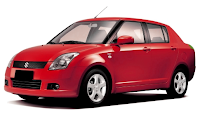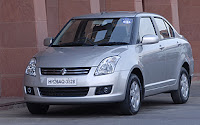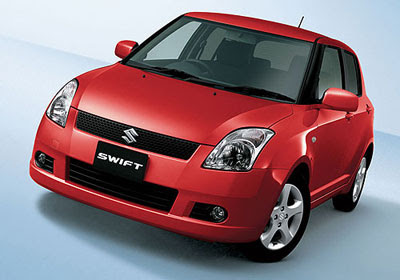Car Review, Car Sales | Maruti Suzuki Swift: an Indian Swift | Suzuki launched
the Swift in
India, as a joint venture product with
Maruti and the car is known as
Maruti Suzuki Swift. In the
Indian auto market,
Swift is available with seven variants four with petrol and three with diesel engine option. The petrol version of
Maruti Suzuki Swift is powered by 1.2-litre K-series engine (with a 1.3-litre petrol engine available utill 2008).
Maruti Suzuki Swift is endowed with five-speed manual transmission. However, the diesel version of
Maruti Suzuki Swift is packed with 1.3-litre, DDiS engine with a displacement of 1,248 cc. The 1.3-litre diesel engine is fitted with a turbocharger and intercooler combination and is endowed with a five-step multi injection common rail system.
 |
| Maruti Suzuki Swift |
- 1,197cc 16V DOHC petrol engine, rated at 63 kW (85 bhp) and 113 newton metres (83 lb�ft).
- 1,248cc 16V DOHC diesel engine, rated at 56 kW (75 bhp) and 190 newton metres (140 lb�ft).
 |
| Maruti Suzuki Swift DZire |
Suzuki introduced a sedan based version of
the Swift called the "
Maruti Swift Dzire" in the Indian market. Launched on March 26, 2008,
Swift DZire replaces
Maruti Suzuki�s popular entry level sedan,
Maruti Suzuki Esteem, production of which was discontinued in late 2007.
Maruti Suzuki has introduced
Swift DZire only in the
Indian market.
The Dzire has exactly the same wheelbase as the hatchback version and has an increased overall length due to the addition of the boot. It shares the same 1.3-litre engine from the
hatchback.
 |
| Maruti Suzuki Swift DZire |
Swift DZire is a result of an indigenous project started in 2005 to design a three-box notchback version of the
Swift hatchback. Some changes have been made to the car�s overall styling to seamlessly integrate the boot. The wheelbase remains the same. The car weighs about 30�35 kilograms (66�77 lb) more than the hatchback. Few modifications in the
rear suspension have been done to cope with the additional weight of the
boot and improve the
ride quality for the
rear passengers. Adjustments in the
rear seat inclination have been made to improve the
rear seat comfort and
legroom. -
Car Review, Car Sales














No comments:
Post a Comment